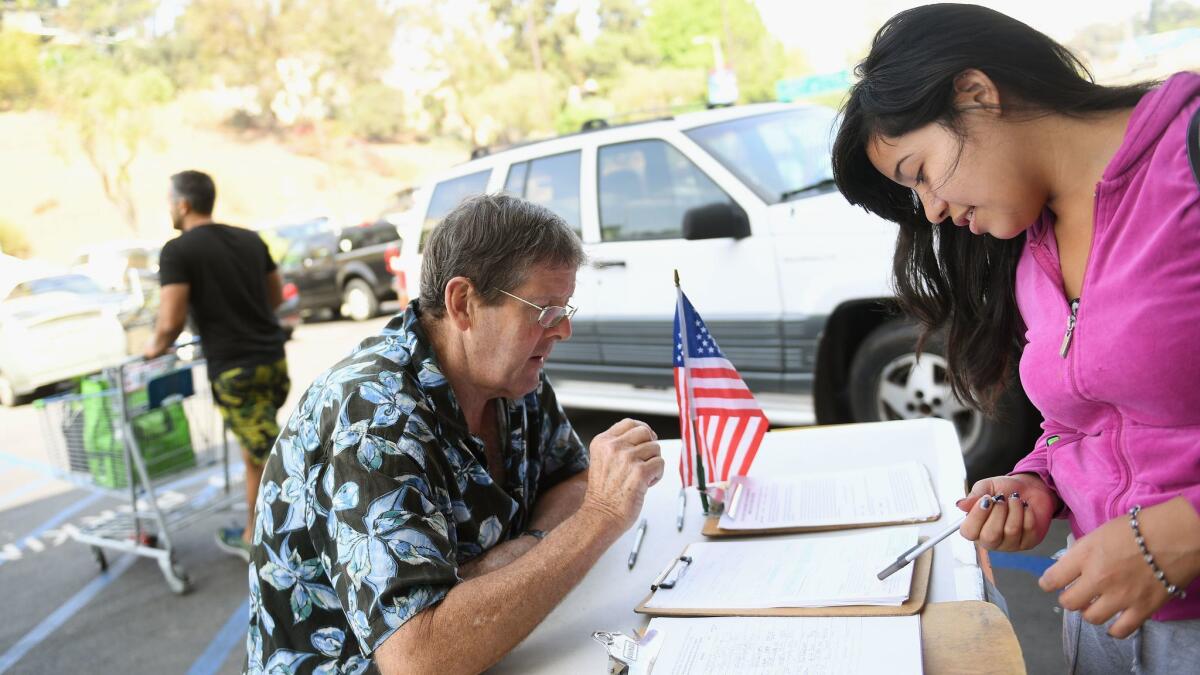Column: There’s a season for California’s 2018 ballot initiatives, and this is it

Reporting from Sacramento — The folding table full of clipboards and flapping sheets of paper — a staple of ballot measure campaigns and thus a hallmark of California politics — is back in front of neighborhood grocery stores and shopping malls.
The race is on to collect voter signatures on any initiative angling for a spot on the Nov. 6 statewide ballot.
State elections officials have suggested there are about 90 days left to gather and submit those signatures on initiatives to write state law, borrow money or amend the California Constitution. After that, the odds become long for tallies to be finalized in time for the formal certification of fall ballot propositions.
Interviews with political strategists and those who circulate initiative petitions suggest that as many as a dozen measures could end up on the final list. Two years ago, there were 17 propositions — the most since Bill Clinton was president.
The buying and selling of consumer data could be California’s marquee 2018 ballot fight »
At this point, only one proposition is official: a $4-billion bond for affordable housing and veterans assistance written by the Legislature. But two more on the subject of housing look likely — one that would expand the power of local governments to impose rent control and another to allow more of the state’s older homeowners to transfer their existing property tax burden to a new residence.
Two ballot measures to radically restructure California’s system of governance, both of which failed to get on the ballot in the past, look more likely this time. One is championed by John Cox, a Republican candidate for governor. It would reshape the Legislature by requiring the selection of some 12,000 neighborhood representatives who then would choose 120 of their peers to serve in Sacramento. Far more disruptive would be the initiative by Silicon Valley investor Tim Draper to split the Golden State into three smaller states. Draper failed to qualify a six-state version of his California carve-up in 2014. Like that effort, this version could be challenged as violating the U.S. Constitution.
Debates over the cost of kidney dialysis and the rights of consumers to keep their information private are both addressed in likely ballot propositions. So, too, is a proposal to require drivers and technicians at private California ambulance companies to be on call during their meal and rest breaks. And this month, a group of powerful national paint companies quietly put $6 million into a campaign for a ballot measure under which taxpayers would pay for lead paint cleanups. That proposal is still a few days away from hitting the streets, but the industry’s cash gives it a good shot at gathering the almost 366,000 valid signatures needed to get it on this fall’s ballot.
This is the group of California voters everyone will be watching in 2018 »
Two proposals would ask California voters to rework or throw out existing law. Crime victim advocates seek to expand the definition of a “violent felony” and thus exclude more prisoners from the expanded parole rules championed in 2016 by Gov. Jerry Brown. Critics of last year’s $52-billion state transportation plan, meanwhile, are pushing a constitutional amendment that would force an up-or-down vote on the increased gas taxes in 2020.
Only one other proposal seems likely at this point: an $8.9-billion bond for water supply and watershed protection.
Whether any of the measures can actually win on election day isn’t clear. But on the journey of 1,000 political miles, the first step is getting your signature outside that local store. And soon.
Follow @johnmyers on Twitter, sign up for our daily Essential Politics newsletter and listen to the weekly California Politics Podcast
ALSO:
Updates on California politics
More to Read
Get the L.A. Times Politics newsletter
Deeply reported insights into legislation, politics and policy from Sacramento, Washington and beyond. In your inbox three times per week.
You may occasionally receive promotional content from the Los Angeles Times.











